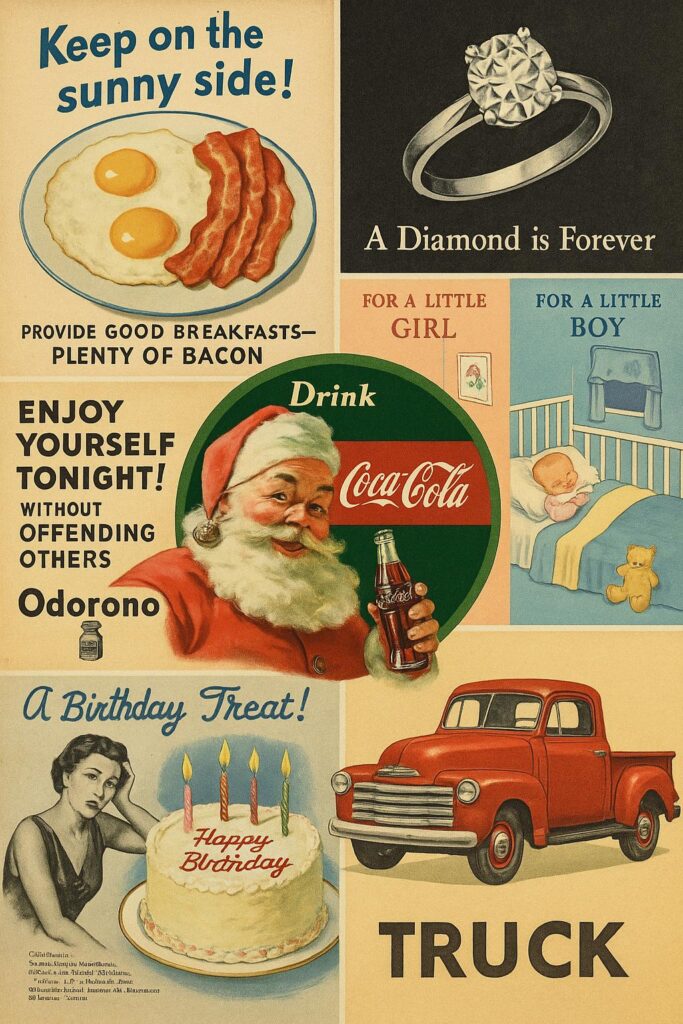Many everyday habits and traditions people now take for granted actually began as clever marketing strategies. Marketers have carefully shaped routines, preferences, and social expectations to increase product sales and cement brand loyalty.
Some of the most familiar customs, like specific breakfast foods or engagement rituals, were directly influenced by campaigns designed to change consumer behavior. It’s not too much to say that they were invented in boardrooms.
Keep reading and you’ll see how normal-seeming choices about food, fashion, holidays, and hygiene were actually steered by commercial interests.
Bacon and Eggs: The Making of a Breakfast Tradition
The classic American breakfast of bacon and eggs did not arise from long-standing custom. In the 1920s, the Beech-Nut Packing Company, which sold bacon, hired Edward Bernays, known as the “father of public relations,” to improve lagging bacon sales.
Bernays surveyed doctors, framing the question so most agreed a hearty breakfast was healthier than a light one. He then publicized the results to suggest that bacon and eggs were the ideal energy-rich breakfast.
As newspapers and magazines picked up the story, households started seeing bacon and eggs as the standard morning meal. This careful orchestration shifted consumer behavior and made what was once a simple choice into a widespread habit.
Key factors in popularizing bacon and eggs for breakfast:
- Medical endorsements for “hearty” breakfasts
- Media coverage of new breakfast norms
- Consistent messaging thar connected bacon to vitality
Diamond Engagement Rings: A Marketer’s Best Friend
The tradition of giving diamond engagement rings started as a calculated campaign by De Beers in the late 1930s. Facing falling diamond sales, the company launched an aggressive marketing effort positioning diamonds as essential to proposals.
They worked with Hollywood studios and magazines to depict diamonds as symbols of eternal love. The famous tagline “A Diamond is Forever” reinforced the message that a diamond ring was the only proper choice for engagements.
Social pressure soon made it feel almost mandatory for a proposal.
Marketing tactics that made diamond rings standard for engagements:
- Collaborations with movie producers to feature diamonds in romantic plots
- Advertising in women’s magazines to set social expectations
- Pushing the “two months’ salary” guideline for ring budgets
- Repetition of the diamond-as-love-symbol message in various media
These efforts turned a previously uncommon custom into an enduring consumer habit.
Santa Claus and Coca-Cola: Branding the Holidays
Santa’s modern image – jolly, round, and dressed in red – owes much to Coca-Cola’s 1930s advertising. Before these ads, Santa appeared in various forms, even wearing green or brown robes.
Coca-Cola wanted to increase winter soda sales, so they hired artist Haddon Sundblom to create a friendly, approachable Santa for their holiday campaigns. His illustrations showed Santa in Coca-Cola’s red brand colors, cheerful and holding a glass bottle.
Newspapers and magazines quickly spread these images, incorporatingthis version of Santa into popular American culture.
Key marketing strategies Coca-Cola used to shape Christmas traditions:
- Consistent use of bright red outfits matching brand colors
- Repeat visual messaging associating Santa with Coca-Cola products
- National ad campaigns during the holiday season
- Placing ads in popular magazines and newspapers
This campaign helped standardize Christmas imagery and influenced holiday celebrations worldwide.

Gendered Colors: Pink for Girls, Blue for Boys
The idea that pink is for girls and blue is for boys didn’t exist until the early 20th century. Before that, babies wore white, regardless of gender.
In the 1940s, department stores, clothing brands, and advertisers began to push pink as feminine and blue as masculine in catalogs and ads. This color coding helped brands sell more clothing by convincing families each child needed new gender-specific items.
Over time, this message shaped nursery décor, baby products, and even toy marketing.
How marketers created the pink-for-girls, blue-for-boys norm:
- Store catalogs promoted gendered color schemes for infants
- Children’s product ads reinforced color associations
- Retailers displayed gender-coded sections in stores
- Magazine articles explained these “new rules” for parents
This approach locked in consumer habits, fueled more frequent purchases and cemented color preferences as cultural norms.
Daily Habits: Deodorant, Showers, and Cleanliness
Deodorant use and daily showers became standard habits also due to targeted marketing campaigns in the 20th century. Before then, personal odor was mostly seen as normal, and bathing routines were far less common.
Marketers behind brands like Odorono and Lifebuoy created urgency by framing natural body odor as embarrassing and socially unacceptable. Ads used persuasive language and staged scenarios to show that skipping deodorant could ruin first impressions or relationships.
As a result, people began buying products to avoid social stigma. Companies also promoted the idea that daily showers were necessary for hygiene, health, and social approval.
These messages appeared in magazine articles, radio ads, and product packaging. To normalize more frequent purchases, marketers connected cleanliness to confidence and modern living.
How marketers encouraged new cleanliness routines:
- Ads describing body odor as a problem that must be solved
- Endorsements by doctors or “experts”
- Campaigns linking fresh scent to success and likability
- In-store product displays emphasizing daily use
Birthday cakes, candles, and parties
Birthday celebrations packed with cake, candles, and elaborate parties didn’t become standard until bakeries and party supply companies began marketing them in the late 1800s and early 1900s.
Cake makers promoted the idea that every birthday needed a special dessert, while candle companies suggested adding one candle for every year. This ritual, amplified by greeting card companies, created a sense of expectation around marking the date with a gathering and gifts.
Retailers encouraged bigger parties by displaying themed decorations and tableware in catalogs and stores.
Key steps marketers used to establish birthday traditions:
- Bakeries advertised personalized cakes as essential for birthdays
- Candle brands pushed the one-candle-per-year tradition
- Card companies introduced birthday-specific greetings to drive card sales
- Party stores highlighted themed plates, hats, and favors for kids’ celebrations
Over time, these products became the backbone of birthday rituals in many households.
Pickup trucks as symbols of masculinity
Pickup trucks became synonymous with rugged masculinity thanks to decades of calculated marketing. Starting in the mid-20th century, auto manufacturers shifted their messaging from utility to lifestyle. They portrayed trucks as tools for tough, hardworking men.
Advertisements featured images of gritty job sites, countryside adventures, and families relying on dad’s pickup for weekend projects. Celebrities, athletes, and country music stars endorsed trucks, solidifying their “manly” reputation.
Marketing moves used to create this norm include:
- Television spots showing trucks conquering rough terrain
- Slogans linking ownership to strength, independence, and reliability
- Print ads depicting men solving problems with their pickups
- Partnerships with rodeos, sports events, and hunting shows
By constantly reinforcing these images and messages, brands established pickup trucks as a defining symbol of masculinity and self-reliance.
The Bottom Line
Marketers have played a central role in shaping behaviors that are now seen as natural parts of everyday life. By connecting products with values, social approval, and identity, they made ordinary items feel essential. Basically, they invented traditions, norms, customs and rituals.
Consistent messaging, the use of cultural symbols, and expert backing made it seem like these things had existed forever.
Spotting these patterns gives people the tools to question trends and traditions, to set their own priorities and to make choices based on real needs.



